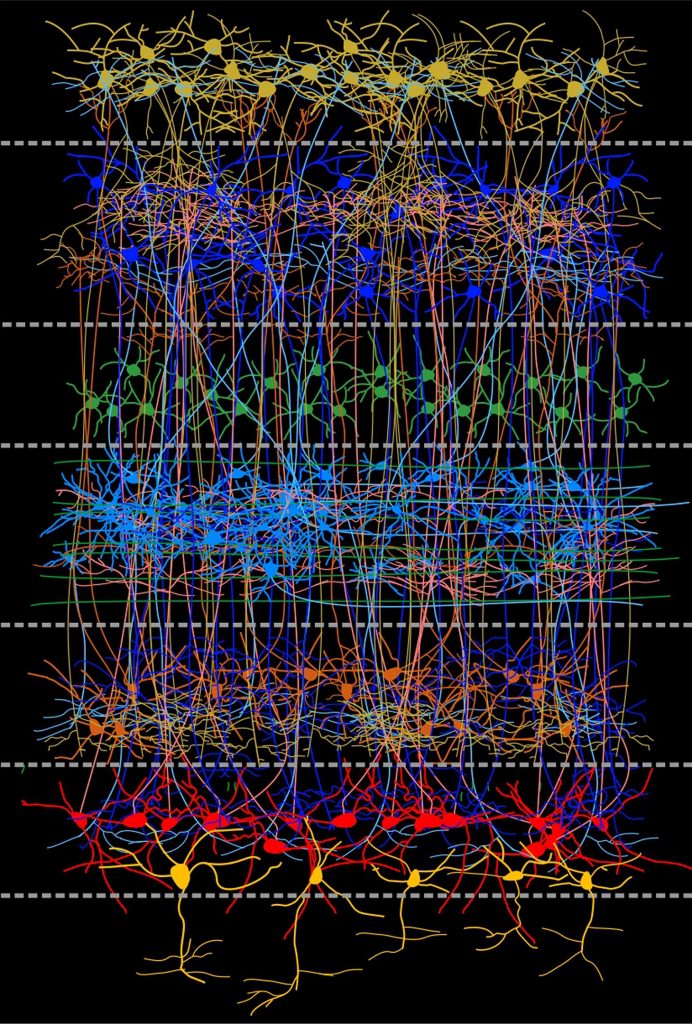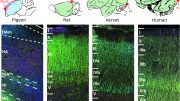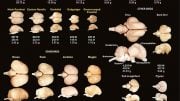
Similar to the cortex of mammals, the nerve cells in certain areas of the brain of birds are organized in vertical layers and horizontal columns. Credit: RUB, Biopsychlogy
Some birds can perform amazing cognitive feats – even though their forebrains seem to just consist of lumps of grey cells, while mammalian forebrains harbor a highly complex neocortex. A study conducted by a research team at Ruhr-Universität Bochum (RUB) and researchers from Düsseldorf, Jülich, and Aachen reveals for the first time amazing similarities between the neocortex of mammals and sensory brain areas of birds: both are arranged in horizontal layers and vertical columns. These findings refute 150-year-old assumptions. The team, published its findings in the journal Science on September 25, 2020.
The largest brains
Birds and mammals have the largest brains in relation to their body. Apart from that, however, they have little in common, according to scientific opinion since the 19th century: mammalian brains have a neocortex, i.e. a cerebral cortex that’s made up of six layers and arranged in columns perpendicular to these layers. Avian brains, on the other hand, look like clumps of grey cells.
“Considering the astonishing cognitive performance that birds can achieve, it seemed reasonable to suspect that their brains are more organized than expected,” says Professor Onur Güntürkün, Head of the Biopsychology Research Unit at the RUB Faculty of Psychology. He and his former doctoral students Dr. Martin Stacho and Dr. Christina Herold proved this in several experiments.
Perfected technology facilitates new insights
In the first step, the researchers deployed a new method perfected by the Düsseldorf and Jülich teams: so-called 3D polarized light imaging, or 3D PLI for short, is capable of displaying the orientation of individual nerve fibers. To the researchers’ surprise, an analysis of the brains of various birds revealed an organization that is similar to that in the mammalian brain: here too, the fibers are arranged horizontally and vertically in the same way as in the neocortex.
In further experiments, the researchers used tiny crystals, which are absorbed by nerve cells in brain slices and transport them to their smallest dendrites, to examine the interconnection of cells in the bird brain in detail. “Here, too, the structure was shown to consist of columns, in which signals are transmitted from top to bottom and vice versa, and long horizontal fibers,” explains Onur Güntürkün. However, this structure is only found in the sensory areas of the avian brain. Other areas, such as associative areas, are organized in a different way.
Amazing cognitive performance
Some birds are capable of astonishing cognitive performances to rival those of higher-developed mammals such as primates. For example, ravens recognize themselves in the mirror and plan for the future. They are also able to put themselves in the position of others, recognize causalities, and draw conclusions. Pigeons can learn English spelling up to the level of six-year-old children.
Reference: “A cortex-like canonical circuit in the avian forebrain” by Martin Stacho, Christina Herold, Noemi Rook, Hermann Wagner, Markus Axer, Katrin Amunts and Onur Güntürkün, 25 September 2020, Science.
DOI: 10.1126/science.abc5534
The study was funded by the German Research Foundation as part of Collaborative Research Centres 1280 (project no. A01 316803389) and 1372 (project no. Neu04 395940726). Additional funding was supplied by the European Union under the umbrella of the Horizon 2020 Programme (project no. 785907 and 945539).









Be the first to comment on "The Surprising Organization of Bird Brains: New Research Clears Up 150 Years of False Assumptions"